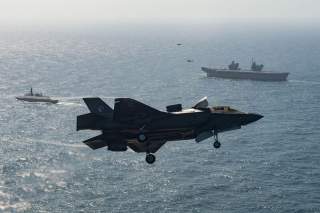F-35s and Aircraft Carriers: Making Great Britain’s Military Great Again?
Let's find out.
The extra money in part came from a $13-billion reserve fund for four new Dreadnought-class ballistic-missile submarines that the Navy is developing at a total cost of around $39 billion, which is nearly as much as the entire British military spends in a year.
The British military is struggling to reorganize for a new cold war in Europe. A modest spending boost in 2018 could give planners some hope that budgetary shortfalls -- a perennial problem for the U.K. armed forces -- might not doom the effort.
(This first appeared late in 2018.)
"After almost three decades of relative international stability, the world has now re-entered a period of persistent and intense state competition," the U.K. Defense Ministry stated in its December 2018 review "Mobilizing, Modernizing & Transforming Defense."
To deter and defeat potential enemies, the study asserted, the British military should be able to deploy a 50,000-person task force including a maritime task group centered on a Queen Elizabeth-class aircraft carrier embarking F-35 stealth fighters, an army division with three brigades, an air force group with combat, transport and surveillance aircraft and a special forces task group.
At the same time, the military must keep at least one nuclear-armed ballistic-missile submarine at sea at all times for strategic deterrence.
But the U.K. armed forces have struggled in recent years to maintain the pool of forces from which the task force and at-sea deterrence would draw. Periodic cuts since the fall of the Soviet Union in 1991 have shrunk the British military roughly by half.
The most recent rounds of cuts starting in 2010 eliminated two aircraft carriers, two amphibious ships, four frigates, an army brigade, more than a third of the army's tanks and artillery and all of the air force's Harrier jump jets and maritime patrol planes. Uniformed manpower dropped by 30,000.
As recently as late 2017, there were rumors that the United Kingdom might try to offset the cost of the country's exit from the European Union by further cutting the military. Army brigades and amphibious ships appeared to be particularly vulnerable.
But funding stabilized at around $55 billion annually. In 2017 and 2018, the government allocated the armed forces an extra $2 billion, combined, above planned spending levels, enough to employ 196,000 active and reserve sailors, soldiers, airmen and civilian personnel.
The extra money in part came from a $13-billion reserve fund for four new Dreadnought-class ballistic-missile submarines that the Navy is developing at a total cost of around $39 billion, which is nearly as much as the entire British military spends in a year.
Banking on the higher level of spending to continue, officials plan on building and maintaining a fleet including two Queen Elizabeth-class carriers, six Type 26 destroyers, eight Type 26 frigates, five low-cost Type 31 frigates, seven Astute-class attack submarine, 24 patrol vessels, 12 minehunters, five amphibious assault ships and nine logistics ships, together embarking six helicopter squadrons and 48 F-35 stealth fighters.
The army would have two tank brigades, two mechanized brigades, six infantry brigades, a parachute brigade and 15 helicopter and drone squadrons, each with around 15 aircraft.
The air force would possess at least 20 Reaper-style armed drones, seven squadrons of Typhoon fighters each with around a dozen planes and two squadrons of F-35s plus 26 patrol, surveillance and command planes, 44 cargo planes and 14 tankers.
The Defense Ministry plans to complete, in 2019, a formal spending review that could add or subtract forces. The biggest risk is potential cost increases in the ballistic-missile submarine program, according to Malcolm Chalmers, the deputy director of the Royal United Services Institute.
If the cost of the submarines rises, less money will be available for transfer from the sub program's reserve fund. Overall, however, the budgetary news is good for the U.K. Ministry of Defense as it prepares for a new cold war in Europe, Chalmers wrote.
"What is clear is that, because of the additional announcements in the budget, the MoD will no longer have to make the immediate reductions in capability – cutting regular army personnel numbers, scrapping amphibious ships and so on -- that were being heavily trailed during the earlier phases of the review in late 2017."
David Axe serves as Defense Editor of the National Interest. He is the author of the graphic novels War Fix, War Is Boring and Machete Squad.
Image: U.S. Department of Defense

